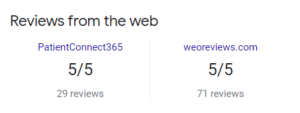
How Do I Check a Company’s Reputation?
Managing your company’s online reputation can feel like a daunting task. The good news is that you don’t need to do everything at once. Constructing a strong reputation isn’t about making one big push—rather, it’s a consistent series of smaller efforts undertaken over time. When it comes to reputation management, slow and steady wins the race.
Let’s look at the small changes you can make right now to more effectively evaluate, construct, and safeguard your company’s image—both today and well into the future. Here’s your guide on how to check out a company’s reputation.
Monitor and respond to reviews all in one place
Social Media Examination
Engagement Levels
Let’s talk about social media—the hub of public opinion. If you have business accounts on popular social media platforms like Facebook, Instagram, and X, this is the perfect time to take a look at your engagement metrics and see how they stack up to those of your competitors.
Are you noticing your posts are receiving high engagement? Then you are off to a great start. Low engagement? It might signify that it’s time to spice things up a bit.
User Reviews and Comments
As you may know, there is more to social engagement than just likes and shares. User-generated reviews and comments are the biggest tellers of where you stand in the public eye so it’s important to keep a close watch of what people are saying and identify any patterns.
You see, potential customers seek out this feedback to help them gauge if they want to do business with you. This isn’t just a one-off thing either—nearly everyone these days conducts an online search before making a purchase, and of those, most seek out negative reviews to see how the company responds to them.
Think about it, would you feel comfortable ordering a product from Amazon if you were aware that the vendor, in the event of any issues, was known to not respond to emails? Of course, you wouldn’t. The same theory can be applied to how you approach customer feedback.
Customer service does not end when the patron leaves your store. A best practice is to respond professionally to the reviews, comments, and questions you receive as soon as possible, no matter the sentiment they may contain. This helps your customers feel heard and supported.
For strategies to effectively respond to reviews—both the good and the bad—check out these resources:
- Reputation Management Examples for Local Service Businesses
- Responding to Bad Reviews: The Dos and Don’ts
- 6 Tips for Responding to Positive Reviews With Reply Examples
Google Search
Review Your Google Reviews and Star Rating
Your Google Business listing might be the first thing a potential customer interacts with before stepping foot in your store. You want to ensure that this first impression is a good one.
According to the Search Engine Journal, 48% of consumers won’t even look twice at a business with less than 4 stars. If yours is hovering around this spot or lower on Google, it might be time to plan some strategies to resolve user complaints, improve your services, and capture more positive reviews from your happy customers.
When it comes to how to check out a company’s reputation, first check your reviews and your average star rating regularly to resolve issues before they escalate. Echoing the previous section, it is best to respond to Google reviews with grace and professionalism to build (or mend) the relationships you have with your paying customers.
“Reviews from the Web” in the Knowledge Graph Sidebar
Don’t forget the Knowledge Graph Sidebar! Scroll down your listing to check out Reviews from the web that Google gathered from relevant and influential sites across the internet. This offers you a broader view of your online sentiment and can give you ideas on what sites to target next for improvement.
Now, you might be asking yourself: Can I add reviews from Facebook or other sites to my Google listing manually? The short answer is no, but that does not mean you can’t make it easier for Google to do it for you.
The more consistent your business’s NAP data (Name, Address, Phone Number) is on review and listing sites, the more likely Google will recognize it as genuine and be more inclined to add it to your listing.
Research Ratings on Top Review Platforms
There are hundreds of review websites out there, so you might be wondering where to start. Some great places you can begin your search include:
- Yelp
- Trip Advisor
- Better Business Bureau (BBB)
- Trustpilot
On top of general review sites, you can also explore websites that are tailored to your specific industry, such as Angi for home services, CARFAX for auto repair businesses, or Rover for pet service providers.
For a comprehensive list of industry-specific review sites, check out our article: Where to Get Reviews for Local Businesses.
Look at What Your Employees Are Saying
Your employees are a direct reflection of the health of your business, not only for potential customers but also for prospective new hires and business partners. Check sites like Glassdoor for insights into your current work environment. Also, keep an eye on website comments and support forums, where past and present employees often discuss their experiences more candidly.
Google Alerts
Stay informed with Google Alerts. It’s like having a personal radar for any mention of your brand, which ensures you are the first to know about changes in online sentiment. Setup takes seconds and is completely free, which is perfect for folks who are running on a tight budget.
Company Website
When researching a company’s reputation, it is also a good idea to check out their website. When you do, look for the following key trust indicators.
Company Mission Statement
Find out what the company stands for and what they’re all about. A clear mission statement tells you their goals and values. A website with no mission statement can be a serious red flag.
Core Values
See if they share their core values. These should demonstrate how much they care about customers and about doing things right.
Customer Service Info
Are they easy to reach? Look for phone numbers, emails, or live chat options. Having this information front and center shows they’re ready to help and are open to hearing from their customers.
Customer Reviews and Testimonials
Real reviews from customers displayed on the website are a great sign. They can tell you a lot about what it’s like to do business with the company; however, stay sharp—if the photos look highly professional or the reviews seem a little too good to be true, they’re probably fake or placeholders.
Contact Info
Check if you can easily find their contact details. It’s a good sign if they’re upfront about how to get in touch.
User-Friendly Site
Is their website easy to use? A secure, fast-loading website with an easy-to-navigate layout shows they take their business and your data seriously.
Also, while you’re at it, take a look at the comments on their blog. Compare what you find on their site with what people are saying on review websites. If there’s a big difference, it could mean their reputation isn’t as good as they say it is.
Leveraging Reputation Monitoring Tools
Now that we have discussed the importance of online reputation and ways you can manage it, it’s time to discuss the options at your disposal to streamline the process: online reputation management tools. There are a plethora of platforms out there that promise the world, but be mindful of which ones you choose to ensure yours is the best fit for your needs.
Some reputation monitoring and management platforms are designed for specific industries, large corporations, or even non-profits. So decide carefully what features you specifically want in a reputation management tool.
For example, Broadly’s Dashboard and Reviews feature is designed specifically for the needs of a local business, keeping you in the loop and on top of your reputation game.
Let’s take a look under the hood at some of the most valuable features you should look for in a reputation management tool:
Social Listening
Social listening is your personal radar for messages spreading around online. Use it to understand the buzz and stay in the public’s good books.
Sentiment Analysis
Want to know if people are cheering or jeering about you? Sentiment analysis identifies trends in positive and negative language. From there, you can compare yourself against competitors and form strategies to improve public sentiment.
Responding to Negative Feedback
When you are faced with difficult feedback, it’s best to have a plan and tools in place to ensure it is responded to effectively. This system is known colloquially as a response protocol.
Response protocol is all about quickly addressing any negativity, showing understanding, and offering helpful solutions. This approach not only resolves issues but also turns them into chances to make things better. With a solid response protocol, businesses can tackle online challenges head-on, demonstrating transparency and professionalism while keeping their public image in check.
Build a Proactive Reputation Management Strategy with Broadly
Establishing a Positive Online Presence
Proactively manage your online presence and encourage satisfied customers to share their experiences online. From email to social media, text messages, and more, you’re prepared to flaunt your stuff.
Encouraging Satisfied Customers to Share Feedback
Turn happy customers into your own biggest advocates. Use tools like Broadly’s Reputation Management Software to make it as easy as snapping your fingers.
Regularly Monitoring and Updating
Consistency is key. We keep a vigilant eye on your online info to make sure it’s accurate, relevant, and reflects your business in the best light.
Take Your Business to the Top with Broadly
Ready to own your online narrative? See what Broadly can do for your business in just 30 days. Start your 30-Day Free Trial and show the world you’re not just a local business—you’re their local expert.
Transform your local business with revolutionary AI-powered software
This article was updated on April 3, 2024.
